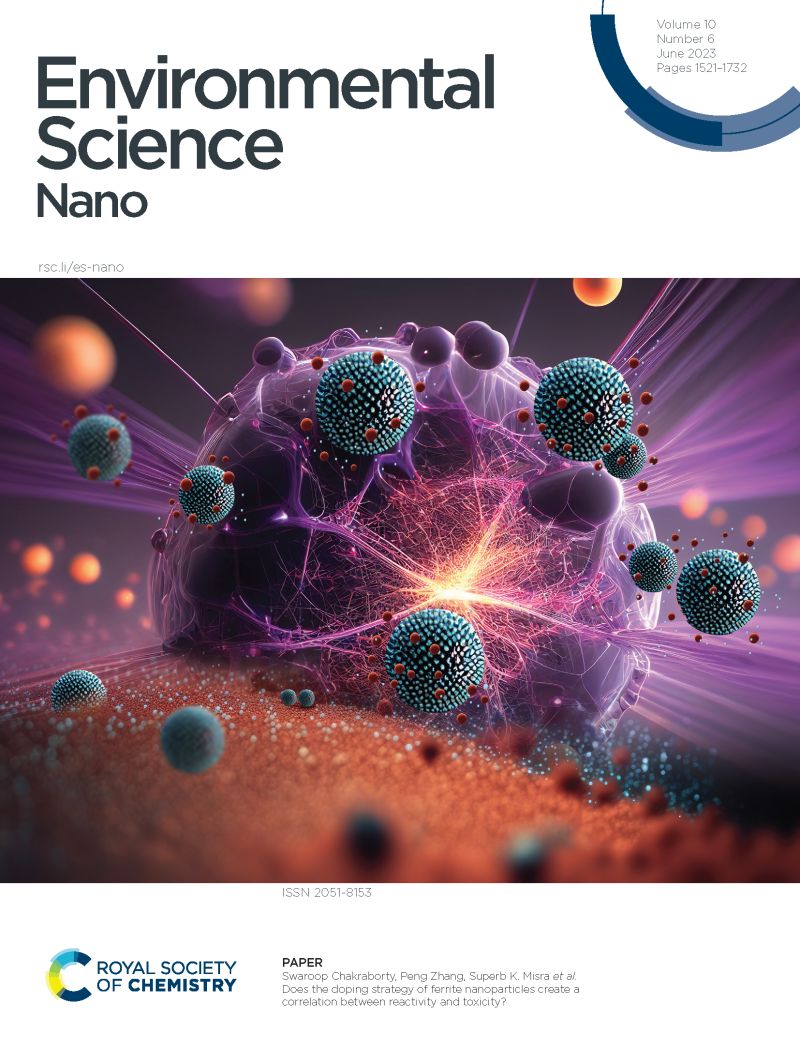Comparative study of the elemental composition of metal(loid)-bearing nanomaterials in wildland-urban interface fire ashes using icp-TOF-MS
IF 5.8
2区 环境科学与生态学
Q1 CHEMISTRY, MULTIDISCIPLINARY
引用次数: 0
Abstract
This study investigates the abundance and elemental composition of metal(loid)c incidental nanomaterials (INMs) in wildland-urban interface (WUI) fire ashes from different sources, including vegetation, structures, and vehicles, collected following the 2020 LNU (the Sonoma-Lake-Napa unit) Lightning Complex Fire in California. Particle number concentrations, elemental compositions and ratios, and size distributions were determined by single particle inductively coupled plasma-time of flight-mass spectrometry (SP-ICP-TOF-MS) coupled with automated two-stage hierarchical clustering analysis. Particle morphologies, elemental compositions, and size were identified by transmission electron microscopy coupled with including energy dispersive X-ray spectroscopy. Iron- and Mn-bearing INMs accounted for >80% of INMs detected in vegetation and atmospheric deposition ashes but they represented <50% of all INMs in structural and vehicle ashes. Together, Al, Ba, Cr, Cu, Ti, Pb, and Zn-bearing INMs accounted for 45 to 75% of all INMs in structural and vehicle ashes and 7 to 13% in vegetation and atmospheric deposition ashes. The sizes of INMs varied between a few tens to a few hundreds of nanometers with larger Ba, Cr, Fe, Ti, Pb, and Zn-bearing INMs in structural and vehicles ashes than in vegetation ashes. Several types of multi-element INMs were identified by SP-ICP-TOF-MS including chromated-copper-arsenate-related NMs (e.g., CuCrO2, CuCr2O4, CrAsO4); CuSn and CuPb alloys; SnPb, SbPb, and SnSb alloys; and CoAl alloys. Overall, this study demonstrates the abundance and elemental makeup of various metal(loid)c INMs in WUI fire ashes. This study highlights the need for further research opportunities into the discovery, transformation, reactivity, fate, and effects of INMs during and following WUI fires.利用icp-TOF-MS对荒地-城市界面火灰中含金属(样蛋白)纳米材料元素组成的比较研究
本研究调查了来自不同来源(包括植被、建筑物和车辆)的荒地-城市界面(WUI)火灾灰烬中金属(loid)c偶然纳米材料(inm)的丰度和元素组成,这些灰烬是在2020年加州索诺玛-纳帕湖单元(LNU)闪电复合火灾后收集的。采用单颗粒电感耦合等离子体飞行时间质谱法(SP-ICP-TOF-MS)结合自动两阶段分层聚类分析,测定颗粒数量、浓度、元素组成、比例和大小分布。通过透射电子显微镜和含能色散x射线光谱学对颗粒的形态、元素组成和大小进行了鉴定。含铁和含锰的INMs占植被和大气沉积灰中检测到的INMs的80%,但占结构和车辆灰中所有INMs的50%。含Al、Ba、Cr、Cu、Ti、Pb和zn的INMs合计占结构和车辆灰中所有INMs的45 ~ 75%,占植被和大气沉降灰中所有INMs的7 ~ 13%。结构灰和车辆灰中含Ba、Cr、Fe、Ti、Pb和zn的颗粒比植被灰中含Ba、Cr、Fe、Ti、Pb和zn的颗粒大。SP-ICP-TOF-MS鉴定了几种类型的多元素纳米粒,包括与砷酸铜相关的有色纳米粒(如CuCrO2、CuCr2O4、CrAsO4);CuSn和CuPb合金;SnPb、SbPb和SnSb合金;和煤合金。总体而言,本研究证明了WUI火灰中各种金属(loid)c - INMs的丰度和元素组成。这项研究强调了在WUI火灾期间和之后对inm的发现、转化、反应性、命运和影响进行进一步研究的必要性。
本文章由计算机程序翻译,如有差异,请以英文原文为准。
求助全文
约1分钟内获得全文
求助全文
来源期刊

Environmental Science: Nano
CHEMISTRY, MULTIDISCIPLINARY-ENVIRONMENTAL SCIENCES
CiteScore
12.20
自引率
5.50%
发文量
290
审稿时长
2.1 months
期刊介绍:
Environmental Science: Nano serves as a comprehensive and high-impact peer-reviewed source of information on the design and demonstration of engineered nanomaterials for environment-based applications. It also covers the interactions between engineered, natural, and incidental nanomaterials with biological and environmental systems. This scope includes, but is not limited to, the following topic areas:
Novel nanomaterial-based applications for water, air, soil, food, and energy sustainability
Nanomaterial interactions with biological systems and nanotoxicology
Environmental fate, reactivity, and transformations of nanoscale materials
Nanoscale processes in the environment
Sustainable nanotechnology including rational nanomaterial design, life cycle assessment, risk/benefit analysis
 求助内容:
求助内容: 应助结果提醒方式:
应助结果提醒方式:


